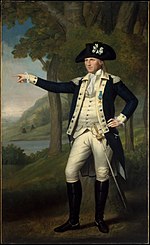Chamberlain Benjamin House
1816 establishments in New York (state)Adirondack Mountains, New York Registered Historic Place stubsFederal architecture in New York (state)Houses completed in 1816Houses in Fulton County, New York ... and 2 more
Houses on the National Register of Historic Places in New York (state)National Register of Historic Places in Fulton County, New York

The Chamberlain Benjamin House is a historic home at 100 South Market Street at the corner of Clinton Street Johnstown, Fulton County, New York. It was built in 1816 and is a 2+1⁄2-story, gable-roofed, brick, Federal period residence. It consists of a three-by-four-bay main block with a long, rectangular 2-story, four-bay rear wing. The interior is based on a side-hall plan. It features a blind-arcade front with brick pilasters and stepped parapet gable ends.It was listed on the National Register of Historic Places in 1999.
Excerpt from the Wikipedia article Chamberlain Benjamin House (License: CC BY-SA 3.0, Authors, Images).Chamberlain Benjamin House
South Market Street,
Geographical coordinates (GPS) Address Nearby Places Show on map
Geographical coordinates (GPS)
| Latitude | Longitude |
|---|---|
| N 43.004166666667 ° | E -74.372777777778 ° |
Address
South Market Street 101
12095
New York, United States
Open on Google Maps








